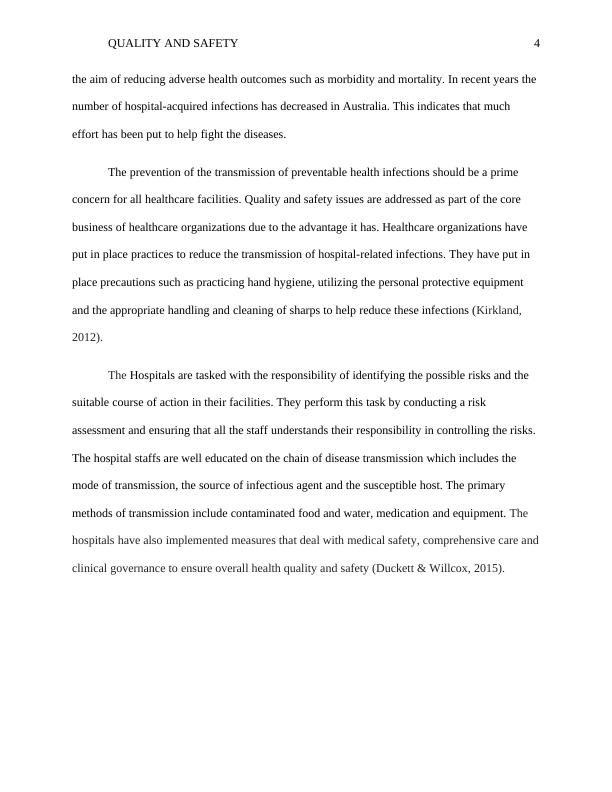(PDF) Quality and Safety in Health Care Management
Added on 2021-06-15
11 Pages2857 Words23 Views
Running head: QUALITY AND SAFETY1Quality and SafetyStudents NameInstitutional Affiliation

QUALITY AND SAFETY2Quality and SafetyQuality improvement is an essential aspect of health care and service delivery. These unexpected infections occur during treatment and have the potential of causing harm to the health of an individual. The common sites of these infections are the surgical sites and the bloodstream. They also create extensive economic losses by increasing morbidity rates and extending the stay of patients in hospitals (Zimlichman et al., 2013). Research indicates that in Australia, there are around 12000 surgical site infections associated with health care and an estimated 17-29% patients die while receiving medication. The number of bed days that result from bloodstream infections is approximated at 206527 bed days.Addressing health care infection and prevention issues effectively requires the participation of everyone together with facility-wide programs. Health care workers have the responsibility of reducing the risk of exposure to these infections for all staff, visitors, and patients. Standard 3 aims at minimizing the risk of the transmission of preventable diseases and efficiently manage these infections using evidence-based strategies. It is structured to involve senior managers, health service executives and clinicians using both a risk management and governance framework method to enhance infection prevention and control. Its overall goal is keeping the public safe from harm and developing healthcare is the priority by preventing and controlling the health care-related infections. Majority of healthcare-related diseases are preventable. The patients in hospitals are always at high risk of acquiring preventable health infections hence more focus should be put on infection prevention.

QUALITY AND SAFETY3Quality and Safety in the Australian health care system Patient safety is the foundation of high-quality health care. Quality healthcare refers to the best achievable health outcomes considering the present conditions and resources dependent on patient-centered care. Safety in the healthcare setting aims at reducing the risk of undesired harm to a tolerably low level. Patient safety is the relief from health care hazards as a result of medical error or medical care and is regarded as one of the elements of the quality framework forhealthcare practice. The Australian health care system provides high quality and safe care to its patients (Runciman, 2012). This is clear from the number of measures they have put in place such as improved health accessibility and availability to patients. This is an essential step towards promoting health, ensuring health equity, reducing avoidable disabilities and reducing early deaths (ACSQHC, 2010).The Australian healthcare has improved quality of resources which include a high number of well-trained nurses, a large hospital bed capacity in hospitals and providing health insurance. The presence of nurses who have undergone advanced training ensures that quality health care and patient-centered care is given to patients. The government has invested in providing health insurance which enables individuals to get timely health care and hence reducing the advancements of undesired health outcomes. It also helps reduce the financial burden on the patients and families (ACSQHC, 2017).Nurses and other stakeholders always work together to ensure maximum safety of the patients. They also play a crucial role in the coordination and surveillance of patient safety with

QUALITY AND SAFETY4the aim of reducing adverse health outcomes such as morbidity and mortality. In recent years the number of hospital-acquired infections has decreased in Australia. This indicates that much effort has been put to help fight the diseases. The prevention of the transmission of preventable health infections should be a prime concern for all healthcare facilities. Quality and safety issues are addressed as part of the core business of healthcare organizations due to the advantage it has. Healthcare organizations have put in place practices to reduce the transmission of hospital-related infections. They have put in place precautions such as practicing hand hygiene, utilizing the personal protective equipment and the appropriate handling and cleaning of sharps to help reduce these infections (Kirkland, 2012).The Hospitals are tasked with the responsibility of identifying the possible risks and the suitable course of action in their facilities. They perform this task by conducting a risk assessment and ensuring that all the staff understands their responsibility in controlling the risks. The hospital staffs are well educated on the chain of disease transmission which includes the mode of transmission, the source of infectious agent and the susceptible host. The primary methods of transmission include contaminated food and water, medication and equipment. The hospitals have also implemented measures that deal with medical safety, comprehensive care andclinical governance to ensure overall health quality and safety (Duckett & Willcox, 2015).

End of preview
Want to access all the pages? Upload your documents or become a member.
Related Documents
Perioperative Nursing Care in Infection Controllg...
|10
|2551
|59
Healthcare Associated Infections in Evidence-based nursing practiceslg...
|10
|2275
|67
NSG3NCR Healthcare project assignmentlg...
|10
|2837
|172
The National Safety and Quality Health Servicelg...
|5
|1137
|149
Importance of Safety and Confidentiality in Healthcarelg...
|8
|2137
|451
Patient Safety and Quality Improvement | Essaylg...
|2
|846
|21
